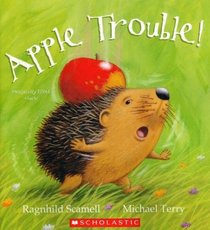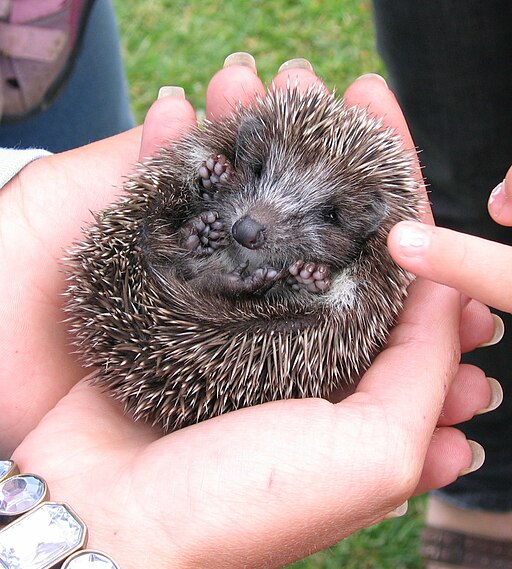Most of the SLPs that I know use children's story books in therapy. They're such a great tool for working on just about any goal! I'd say it would be a rare week for me to not use at least one book in therapy. So, I decided to share my Book of the Week!
This week, we are reading "Apple Trouble" by Ragnhild Scamell and Michael Terry. In this story, a cute little hedgehog (have I mentioned that I have a strange affinity for hedgehogs?) has just finished building a nest under an apple tree when an apple falls on her back and gets lodged on her spines. With the apple on her back, she can no longer fit in her new nest. Hedgehog meets a few animals in her quest to remove the fruit and, in the process, ends up with all sorts of items stuck on her (a juicy red apple, three brown nuts, a small green pear, a crumpled brown leaf, a colorful piece of paper, a pink water lily, and four ripe blackberries). In the end, she meets a goat who eats the items off her back (with the exception of the leaf) and she can finally return to her nest.
What I LOVE about this story:
Well, really everything! Did I mention my love of hedgehogs? Also, the pictures are great (although most of my kids think the goat is a sheep). The vocabulary: "juicy" red apple, "crumpled" brown leaf, plus sentences like this: "hedgehog pattered over to the pond and gazed at her reflection in the water." There is a message of cooperation and helping others. Best of all, it keeps the attention of the children and they all love the story!
How I use it in therapy:
This book really lends itself to my in-class groups, so I use it there. I'm sure it would work well in small pull-out groups as well. I have this cute little hedgehog stuffie I found last summer on vacation in New Hampshire. I show it to the kids and ask if they know what kind of animal it is. I usually get a very adamant, "Porcupine!" When I tell them that it's not a porcupine, I get less sure answers: "Skunk?" "Raccoon?" "Groundhog?" Then repeats of the aforementioned animals until I tell them that it's a hedgehog.
We then talk about the differences between hedgehogs and porcupines. I keep this basic because I'm typically dealing with preschoolers with this story. Porcupines are big, hedgehogs are tiny. Porcupines can shoot their quills to protect themselves, hedgehogs roll into a ball. I show them photos of an actual hedgehog. I have some from a birthday party I attended (thank you Alyssa and Aiden!), but you can probably find some decent ones online, like the ones below. I like using pictures with a person's hand in it so the children can understand how big a hedgehog is. If I show a hedgehog along without any contextual cues, kids think they are large animals.
Then I read the story (I know, this was probably implied!). I drew a hedgehog on a large poster board and made the story props with a die-cut machine at my school. As I read the story, I (or the kids, depending on the size of the group) add the objects to the hedgehog poster, then remove them as the goat eats them.
After the story is over, I ask comprehension questions and have the students retell the story with the props.
IEP Objectives Targeted:
Vocabulary (animals, adjectives, synonyms, categories)
Sequencing (order of items that fall on hedgehog)
Retelling a story in sequence
Answering comprehension questions about a story
Exclusion (goat eats all items except the leaf)
Increasing MLU
Articulation: I have a few students working on /l/, so we worked on: apple, leaf, lily, silly, etc.
Do you use this book as well? What other activities do you do with it?
Update: I love this book so much that I created a book companion, which is available in my Teachers Pay Teachers Store.





